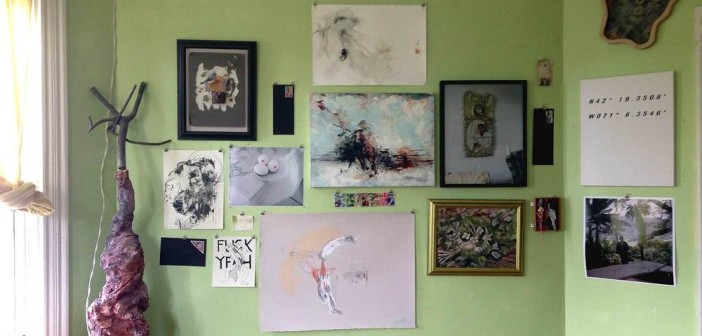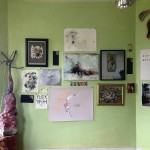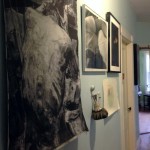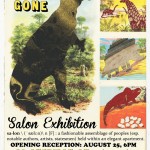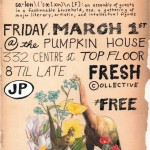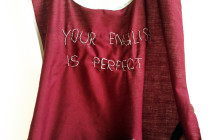Returning to the "Pumpkin House," a burnt orange triple-decker in Jamaica Plain's Hyde Square, was as surreal and potent in many respects as attending the opening event. This most recent exhibit by the local group, Fresh Collective, entitled Not All Gone, packed the walls from floor to ceiling with the work of over thirty artists—among them students from MassArt and SMFA, art school graduates, and artists without any traditional art school training. A self-described salon des refusés, the exhibition clearly wields the democratic language of the refusés in the midst of several prominent efforts to invigorate the local contemporary arts scene.
The collective claims its roots in an earlier project, Fresh Cart, a bicycle/tricycle art "vending machine" that sells pretty much anything that its courier can fit on it. "Like the Fresh Cart and how we can take it to any place without really having a venue or anything like an agenda, we could make our own thing happen," said Pat Peltier, co-organizer of the exhibition with Michael Haas, "Let's do that with an art show." Haas and Peltier were inspired to start Fresh Collective during the summer of 2012 as they were moving out of their JP apartment on Sheriden Street. Faced with a week of empty space they said, "what if we just turned our space into a gallery?" The resulting project was their first salon-style exhibit, Where Have The Dinosaurs Gone, and opened in August 2012.
The most impressive aspect of Fresh Collective, however, has been its focus on community. The value of collaboration in a young artist community cannot be understated. In a market where only a few artists are able to subsist on their work, young artists look to one another for inspiration, criticism, and motivation to keep producing. Working artists "fight to make art after work and on weekends," said Peltier, "And it happens, but it doesn't always. You know if you don't show it or show other people it doesn't always feel as real."
With thirty-five colleges, universities, and community colleges in Boston alone, the city's academic institutions produce a large number of the young artists who emerge into the local art scene. Social circles of artists who create and exhibit work together, build connections together, and are often connected to specific gallery spaces provide the primary gateway into public exhibition and often serve as the most direct path into the city's South End galleries.
It is the DIY house shows like Not All Gone that provide the bedrock from which these support systems grow and flourish. "I think there is such a stronger current going on in JP, in Allston, in Roxbury that just doesn't get seen," said Haas. Haas and Peltier say that creating highly accessible opportunities to show work is essential in order for young student artists to root themselves in Boston and continue making work. Haas added that they wanted Fresh Collective to serve a "gateway art experience" where most of the work on display was admitted depending only on who dropped work off. This style of selection has been used in some notable exhibitions within more conventional gallery spaces as well, particularly Chain Letter, in 2011 which ran at Samsøn as part of a series of exhibitions under the same title at ten galleries around the world. In Chain Letter ten artists were asked to invite ten of their friends, and each of them ten more of their friends, and so on. Such exhibits make First Friday and the South End accessible to young artists in a unique way.
Haas and Peltier stressed that opening the exhibit on a First Friday also expanded the scope of the popular monthly art crawl in terms of geography and variety. It gave art-goers an alternative to the South End, and a place to meet up with friends and wind down after the conclusion of events in SOWA. For the artists who participated, it was a new opportunity to be a part of the evening as well as a new reason to look forward to future First Fridays. "It just gets people excited to make work," said Haas. They pointed out that although many of the artists from Fresh Collective's first show also exhibited work this time, all of the work was new and most of it was made in late 2012 or early 2013.
Borrowing from Renny Pritikin's "Facets of a Healthy Art Scene," recently published on this blog, I asked them whom they saw as the heroes and role models for young artists in Boston. Haas responded, "I like to draw inspiration just from people within the community, because they're real people." "You can talk to them," Peltier added, also mentioning Greg Burdett (aka MRNVR) of the Thomas Young Studio as an inspiration. Burdett recently dedicated a room in his apartment as exhibition space. They said that another show is in the works and currently slated for the end of the summer, although they are still deliberating on a time and venue. To other artists interested in producing DIY house shows they had one piece of advice: "make sure you have a place to put your stuff."
- Installation shot of Not All Gone Photo: Kevin Benisvy
- Installation shot of Not All Gone Photo: Kevin Benisvy
- Exhibition poster for Where Have The Dinosaurs Gone, the Fresh Collective’s first salon-style exhibition. August 2012. Collage by Michael Haas, text by Pat Peltier and design by Nick Schlerf. Via Fresh cART’s Facebook page.
- Exhibition poster for Not All Gone, Fresh Collective’s most recent exhibition. March 2013.
For more information about Fresh Collective or Fresh Cart, contact Michael Haas and Pat Peltier at thefreshcart@gmail.com.

